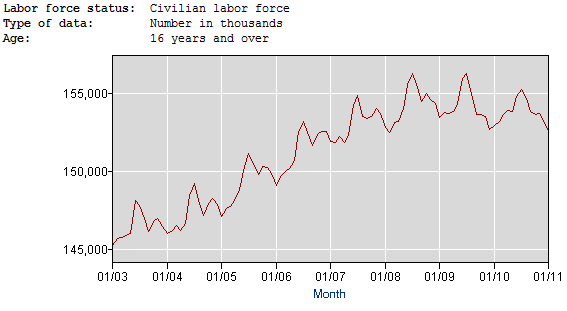Total nonfarm payrolls fell by 2.9 million in January from December. These are the actual numbers, not the Bureau of Liar Statistics seasonal fudge pack which usually obscure the truth, or completely mislead. In order to reveal how the current numbers stack up, it is only necessary to compare them to past years. Given that the BLS has dropped a thousand words from the labor force, here are the pictures. To begin with, January's drop in non-farm payrolls is about the same as last year's at 2.898 million versus 2.869 million. We'll consign this year's slightly worse performance to rounding error.
Private payrolls dropped by 2.4 million, which was also the same as last January. In these two measures it would at least appear that the situation isn't getting any worse. But it's showing no improvement. Stagnant is especially bad since the working age population is still growing.
Until last year, government employment had helped the numbers hold up to the extent that they could have been even worse if that were not the case. That prop is now being withdrawn thanks to state and local government budget woes. Government employment fell by 494,000 in January. Last year it only dropped by 464,000 in January. The growth trend in government employment has reversed.
States haven't cut back much.
Local governments have. Local government employment has been downtrending since 2009. State budget woes are such that lower state employment ahead is in the bag.
The labor force shrank by 620,000 in January. Last year it rose by 264,000. If the BLS wants to lower the unemployment rate, like it did this month-- presto change-o! This is how it's done.
The total number of unemployed persons (by the BLS definition) rose by 940,000. This was a big improvement over last January when it was up by 1.4 million. Fewer people were unemployed. That's good, right? Not if they were dropped out of the labor force statistic, which is what the government did. If people get tired of looking for work and stop looking, the government no longer considers them unemployed.
The total number of people not in the labor force rose by 395,000. Last year that number fell by 355,000. It's nice that so many people were able to retire this year.
The ratio of employment to population fell by 7/10 of a percent in January, dropping the ratio to a new low of 57.6% for this depression, and the lowest level in 27 years. Last year, the drop was only 4/10 of a percent.
The labor force participation rate fell 2/10 of a percent to 63.9%, also a new low, and the lowest level in 25 years.
They didn't post a chart yet for this last statistic. The total unemployment rate including those who have stopped looking for work and those working part time because they cannot find full time work rose to 17.3% in January from 16.6% in December. It was 18% in January 2010. This is the real unemployment rate. Not many mainstream media types report that near the headline. It's usually buried way down in the last paragraph.
All in all, it appears that Bernanke's money printing machine in the basement isn't doing anything to grow jobs. Instead of printing money to deposit in primary dealer trading accounts, maybe the Fed should print the money and put people on its payroll directly. But now that we know for sure that Bernanke's plan isn't working, sadly, we also know from his past behavior what his response will be. Print more money.
This article originally appeared at the Wall Street Examiner.
















